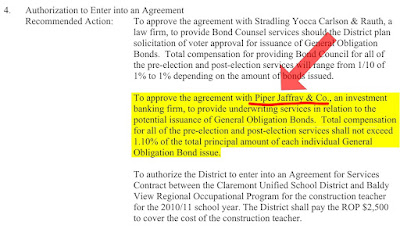 As you may have heard, Saturday's edition of the Claremont Courier raised a lot of questions about the financing behind CUSD's Measure CL campaign.
As you may have heard, Saturday's edition of the Claremont Courier raised a lot of questions about the financing behind CUSD's Measure CL campaign.
Courier reporter Tony Krickl got a Nancy Mintie-style response from Yes on CL treasurer J. Michael Fay as he answered Krickl's questions about the source of the majority of the Yes money. Fay's response seemed to underscore rather than refute bond critics' concerns about the enormous amounts of money pumped into the Yes campaign by out-of-town school contractors:
“These aren’t just outside interests,” said J. Michael Fay, campaign treasurer for Yes on Measure CL. “Most of the companies have already conducted business in the district with Measure Y. So now they’ve volunteered to support the [Measure CL] campaign.”
Fay went on to say that any future school district contracts would have to go out to bid, so there's no quid pro quo involved. Fay, however, overlooks the fact that these bond servicing companies and contractors have a big picture to consider. This could just be thank-you money for past contracts, and dollars given here in Claremont can translate to contracts with other districts.
We got to thinking about this and looked back at the sources of some of the big money for Measure Y, CUSD's last bond measure in the June 2000 election. One of Measure Y's campaign donors was the architectural design firm Flewelling & Moody. On 5/11/00, F & M donated $2,500 to the Yes on Measure Y campaign. On 5/30/00, the week before the election, F & M made a second donation of $2,500.
Did they receive any consideration in return? We can't say for sure, but F & M's website does list Claremont Unified as one of their clients from 2005:

Flewelling & Moody has kicked in $5,000 so far for the current Yes on CL campaign. Judging from the way it went after the last Claremont school bond, if Measure CL passes, there's no telling what sort of contract they might land five years hence after everyone's forgotten about this election.
When one roots around, one starts to find all sorts of things. For instance, F & M, as well as the San Rafael financial advising firm Northcross Hill & Ach (another $5,000 Yes on CL donor) and Rancho Cucamonga-based WLC Architects (a whopping $25,000 to the Yes on CL campaign), are all sponsors of the Claremont Chamber of Commerce. So we shouldn't be surprised that the Chamber's governmental affairs committee voted to endorse CL after meeting with the Yes on CL campaign team and without seeking to hear at all from the No side.
The best CL information on the contract side of things comes from the agenda for the July 22, 2010, CUSD school board meeting. That was the same meeting where the school board approved the resolution to go forward with a bond election. Item 4 on that agenda was the approval of an agreement with Minnesota-based investment bank Piper Jaffray & Co. (see page 3 of the full agenda at the end of this post).
Piper Jaffray has so far donated $25,000 to the Yes on CL effort. Getting back to that July 22 meeting, the Claremont school board agreed to employ them as bond underwriters should CL pass. In return, Piper Jaffray would receive the following:
Total compensation for all of the pre-election and post-election services shall not exceed 1.10% of the total principal amount of each individual General Obligation Bond issue.

Hmmmm, let's see....1.10% of $95 million (the maximum amount CUSD could seek under CL)? That's $1,045,000. Not at all a bad return on $25,000 in what amounts to, uh, marketing costs. All CUSD has done is put the big money carrot up front instead of at the end of the campaign.
Bond counsel Stradling Yocca Carlson & Rauth also stands to make a decent bit off CUSD property owners from a successful Yes on CL campaign - up to 1% of the total bonds issued.
This is precisely where Yes on CL campaign consultants like Jared Boigon and TBWB Strategies could easily act as facilitators, getting contractors to underwrite bond campaigns in some places and then offering introductions between those same contractors and other districts that have successfully passed their bond measures with the aid of these ever-helpful consultants.
It's a great business model, earning Boigon and TBWB $35,000 from the school district for pre-campaign polling services, along with another $10,000 as of September 30 from the Yes on CL campaign. And the money wheel keeps spinning as long as voters are naive enough to believe the misinformation issued forth from the mouths of people like Michael Fay, who manages to remain credible in our community no matter how many times he and his friends play this game.
We can't help but stand in awe at the hypocrisy of those among the Claremont 400 who are pushing this incredibly flawed school bond. One sees this when the League of Women Voters complains about the U.S. Supreme Court's Citizens United decision opening up the floodgates to corporate election contributions as the local LWV chapter stays silent when companies with financial stakes in a successful bond campaign donate all but $2,000 of the $66,027 (and counting) raised by the Yes on CL campaign.
So, let's get this straight. Investment banks contributing to the campaigns of elected officials in charge of financial reform? Bad. Investment banks contributing to school bond campaigns they stand to earn $1 million from? Good.
Hypocritical? Certainly. But, heck, if you're a Claremont 400 critic, we suppose it's job security.
Here's the business operations agenda for that July 22, 2010, CUSD school board meeting:





